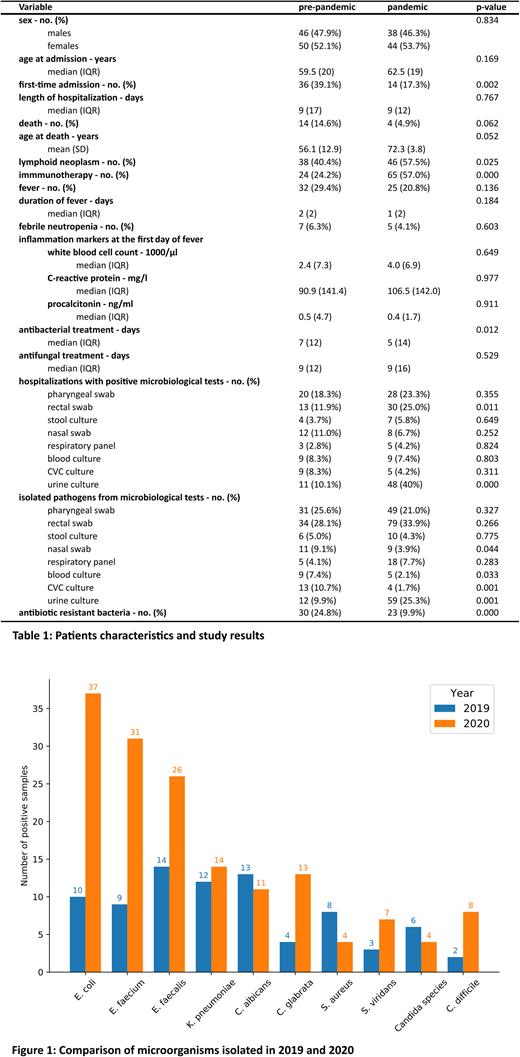Abstract

The COVID-19 outbreak has diametrically changed the epidemiological situation worldwide. Measures to reduce the spread of SARS-CoV-2 had an impact on the incidence of other infections, including nosocomial infections (NIs).
The aim of this study was to investigate the impact of COVID-19 on the prevalence of NIs among patients with hematologic malignancies hospitalized in our Department. This population constitutes a specific group of patients due to secondary immunodeficiency resulting from underlying disorders and administered treatment. Consequently, these patients were particularly protected against infections before the emergence of SARS-CoV-2. For this reason, the analysis of NIs prevalence in the pre-pandemic and pandemic time appears to be interesting. To the best of our knowledge, it is the first scientific report to analyze NIs in terms of pandemic and simultaneously strictly devoted to hematologic conditions.
This is a retrospective analysis of patients treated at the Clinical Department of Hematology in Cracow, Poland, from March to May 2019 (pre-pandemic) compared to the same period in 2020 (pandemic). The hospital information system collected patient characteristics and data on NIs (clinical manifestation, laboratory findings, microbiological test results). All analyzes were performed with STATISTICA, version 13.3. Categorical variables were compared between the pandemic and the pre-pandemic era with χ2-test and its modifications, if appropriate. The normally distributed continuous variables were compared using a t-test and the non-normally distributed using the Mann-Whitney U test. The statistical significance level was chosen as .05. A p-value of less than .1 but not reaching .05 was considered marginally significant.
We analyzed 109 hospitalizations (96 patients) before and 121 (83 patients) during the pandemic. The cohorts did not differ significantly in terms of sex and age at admission, but more deaths and a lower age at death were observed before the pandemic (p = .062 and .052, respectively). The most common cause of death was pneumonia (5/18 patients in total). Although the duration of hospitalization was similar between periods (p = .767), there were more first-time admissions in 2019 (p = .002). This observation suggests a decrease in the proportion of patients who present to healthcare units during the pandemic. The number of fever episodes and their duration were comparable between both periods (p = .136 and .184, respectively). In post hoc analysis, we found that lymphoid neoplasm cases were positively related to the number of fevers and their duration (p = .019 and .064, respectively). The same trend was observed if management was based on immunotherapy, mainly anti-CD20 monoclonal antibodies (p = .031 and .068, respectively). The inflammation markers (white blood cell count, C-reactive protein, and procalcitonin concentration) investigated on the first day of fever were similar (p = .649, .977, and .911, respectively) between the compared periods. Symptomatic infections mostly affected the respiratory system (pre-pandemic: 6% hospitalizations, pandemic: 5%) and urinary tract (pre-pandemic: 3% hospitalizations, pandemic: 2%). The duration of antibacterial treatment was significantly longer before the pandemic (p = .012). In this period, fewer hospitalizations were also associated with the administration of chemoimmunotherapy (p = .000), which is a proven risk factor for infectious complications. During the pandemic, more microorganisms were isolated from the samples (p = .036). In 2020, there were more hospitalizations with a positive rectal swab and urine culture (p = .011 and .000, respectively). However, more pathogens were isolated from nasal swabs, blood, and CVC cultures in 2019 (p = .044, .033, and .001, respectively). Furthermore, the samples revealed a higher proportion of drug-resistant strains before the pandemic (p = .000), especially regarding urine culture and pharyngeal swab (p = .025 and .055, respectively).
Our study suggests that the applied COVID-19 prevention strategy impacted the prevalence and severity of NIs in our material. We demonstrated that strict isolation and extensive use of personal protective equipment could reduce the number of infections caused by pathogens with antimicrobial resistance, the duration of antibiotic therapy, and the number of deaths due to NIs in younger immunocompromised patients.
Disclosures
Sacha:BMs-Celgene: Honoraria, Speakers Bureau; AOP Orphan: Honoraria, Speakers Bureau; Angelini: Honoraria, Membership on an entity's Board of Directors or advisory committees; Adamed: Consultancy, Honoraria; Incyte: Consultancy, Honoraria, Speakers Bureau; Pfizer: Consultancy, Honoraria, Speakers Bureau; Novartis: Consultancy, Honoraria, Speakers Bureau; Bristol Myers Squibb: Consultancy, Honoraria, Speakers Bureau.
Author notes
 This icon denotes a clinically relevant abstract
This icon denotes a clinically relevant abstract
Asterisk with author names denotes non-ASH members.


This feature is available to Subscribers Only
Sign In or Create an Account Close Modal